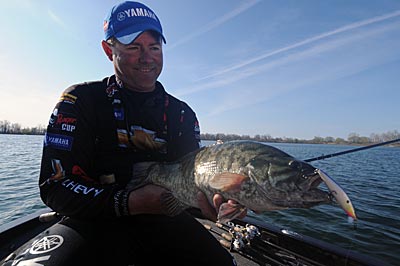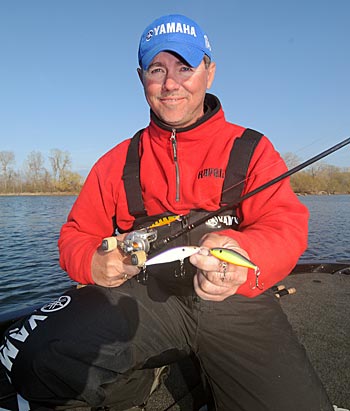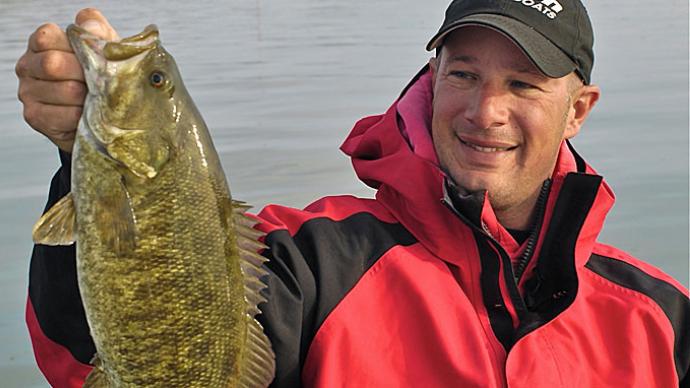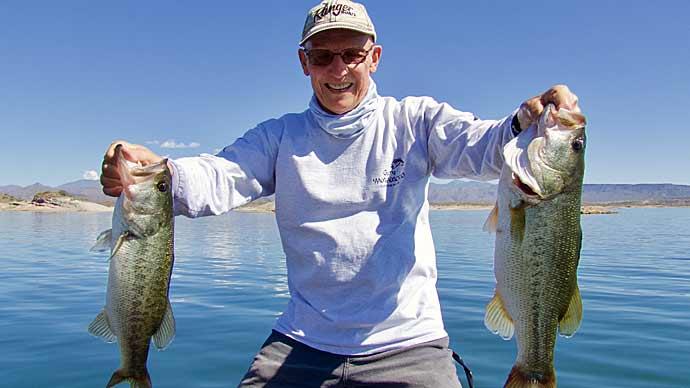
When fishing Southern reservoirs containing smallmouth bass populations, Pennsylvania pro Dave Lefebre prefers running up tributaries to fish for largemouth bass.
However, when he fishes in his home waters of Lake Erie and other Northern lakes, Lefebre concentrates on brown bass because the fish are the dominant species in those waters.
While other anglers frequently target smallmouth foraging for gobies and crayfish along the bottom, Lefebre favors throwing a suspending jerkbait for brown bass keying on baitfish. He believes the killer instinct of smallmouth and the erratic action of the jerkbait trigger the fish into biting the lure. Lefebre also notices the long, slender body of the jerkbait, and the action it produces mimics the looks and motions of smelt and emerald and golden shiners, which are the dominant baitfish on Lake Erie.
Jerkbaits work best for Lefebre during the colder months of spring and fall and the postspawn. He has also caught smallmouth jerking the lure on windy days during the summer. The lure produces best in nasty weather when waves are white capping over a point or flat. However, Lefebre will also throw the lure on foggy calm mornings when smallmouth pop the stickbait when he pauses it.
The jerkbait works best around typical smallmouth hideouts such as grass, holes in the grass, rocks mixed with grass, rock piles, or boulders. Lefebre also catches smallmouth on jerkbaits along flats after ice out, points close to spawning areas and mouths of bays.
The Major League Fishing (MLF) pro has used a variety of Rapala stickbaits throughout the years and is now a fan of the Shadow Rap. He prefers the erratic action generated by the Shadow Rap’s small lip, and the colors of the lure best mimic the baitfish of Northern waters. In addition to the natural colors, Lefebre tries jerkbaits tinted with a chartreuse hue because “smallmouth are just addicted to it.” He likes to throw other bright colors in gin-clear water: pink and orange.
Another staple in his tacklebox is the Rapala X-Rap featuring a feathered tail. “It is still magical, and I have to have them,” Lefebre says. He notes the lure is especially effective on the days when he has to pause the lure and allow the fish to decide if the lure looks real enough to eat. On calm days when smallmouth are finicky, Lefebre will scale down from the larger X-Raps to the 1 1/2-inch model to coax bites.
Fishing for musky with his dad gave Lefebre a valuable lesson on throwing giant baits for smallmouth. He recalls they would throw 7-inch F18 Original Rapalas for musky and frequently caught giant smallmouth on the lure, which he now uses to target heavyweight brown bass and fire up smallmouth schools. His favorite colors for the magnum jerkbait are orange, black-and-gold, and black-and-silver.

The touring pro makes a few modifications to his jerkbaits. “Ninety-nine percent of the time when I am smallmouth fishing, I take the split ring off and use a tiny snap because I switch baits a lot,” Lefebre says. He only leaves the nose split ring on when he fishes the lure with long pauses during his retrieve. He also replaces the factory hooks of jerkbaits with a VMC Hybrid Treble Hook, with a short round bend on the trebles. Lefebre will also add a feathered hook on the Rapala RipStop, which he calls a dynamite bait. “The faster you can jerk it, the quicker it stops,” he says.
The key to Lefebre’s jerkbait presentation is making a long cast. “It seems like a lot of times the fish you catch are real close to the boat or far away from it,” he says. The ability to make long casts even into headwinds allows him to catch fish farther from the boat and those that follow the lure to the boat.
A fast, erratic retrieve produces the most strikes for Lefebre’s jerkbait tactics. “It seems with the other bass species, the jerkbait deal is more about the pause, and with the smallmouth, it is more about the action,” Lefebre says. “I don’t want it to be a cadence where it is predictable. I usually do two real hard snaps to get it down and then pick up slack and do one or two hard jerks.” Lefebre snaps his rod like a whip to create his jerking action of the lure, and sometimes he likes reeling the jerkbait “100 miles an hour and then stopping.”
Lefebre also employs a variation of the figure 8 trick he learned from musky fishing at the end of his retrieve. When he is fishing off-colored water, Lefebre sweeps his jerkbait in a half circle near the boat to tempt any smallmouth following the lure back to the boat.
The former FLW Tour and Bassmaster Elite Series pro prefers working his jerkbaits on baitcasting tackle. He prefers a 6-foot, 10-inch medium action 13 Fishing Envy Black casting rod matched with a 13 Fishing Inception Slide (8.1:1 gear ratio) baitcast reel. He mainly throws 8- or 10-pound Sufix Invisiline Castable Fluorocarbon, allowing him to work his jerkbaits deeper. Lefebre will throw his jerkbaits on 15-pound Sufix 832 Advanced Superline Braid when he needs to make longer casts in tough conditions.
Lefebre’s jerkbait tactics produce both big smallmouth and numbers of brown bass, but he believes jerking for smallmouth is more of a numbers game. “Where I live, it is not uncommon to catch 100 fish off one spot with the jerkbait,” he says.
BassResource may receive a portion of revenues if you make a purchase using a link above.




